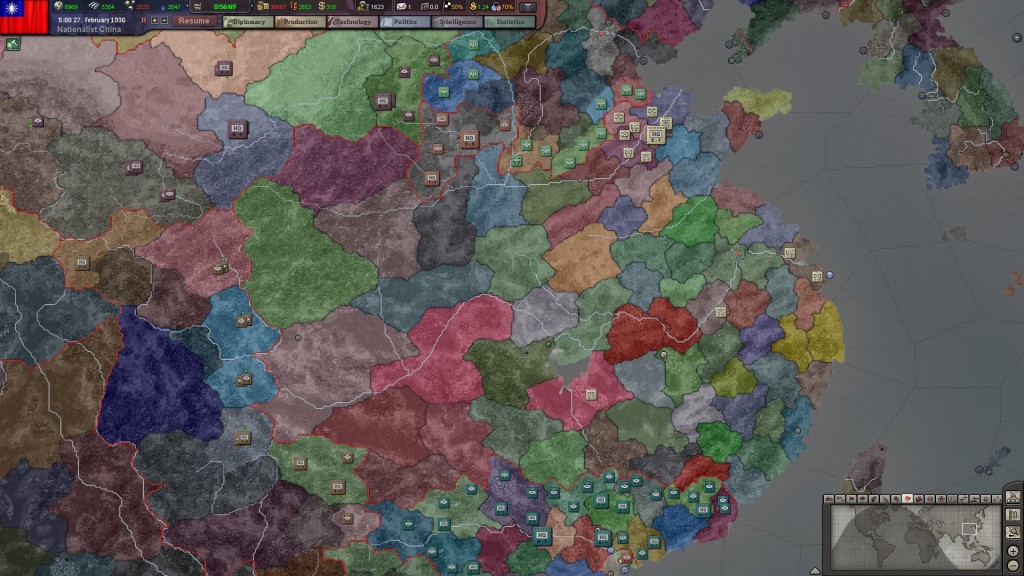

The production window, where you manage resources, produce units and manage trade.
But this control is also where the game falls down. Nothing is explained well. A tutorial is present, although it is text only and ultimately too quick and shallow to be of any help in such a deep game. It is necessary to read the manual through, which is well done. There are also great resources online to help players get accustomed to the game. Once this very steep learning curve is cleared, the game is very enjoyable, but the learning curve is so steep that many will just give up.
Starting up the game, players are greeted with a quite lengthy load screen. This can be a bit annoying, but it does mean that after this, any loading times within the game are very short. All games are played on the same “map”, i.e the World, at different points in time, so once this is loaded everything is quick. The game is real-time, meaning that time is always progressing. The player can choose the speed at any time, though in stable peace time, even the fastest choice can be too slow. It can get boring when you are waiting for something specific to happen, and everything on the home front is good. When at war, however, the game gets very hectic while managing troops, and repeatedly pausing and assessing the situation is common.
There are various map modes to help players easily assess their country, along with those around them. With terrain, political, diplomatic and regional map modes, among others, the game really lends a hand to help with inter-country relations. These allow you to see quickly those countries that you are allied with, at war with, those that are puppet states (protectorates), along with their relations to you. The graphics for military units are quite outdated, but there is an option to change these to counters, which look much nicer and also show more information on them. These counters are shown in the screenshots.

The region map mode, with the unit counters shown on the top and bottom.
Players control many things via streamlined sliders, for example the production window, where IC (Industrial Capacity) is shared between various tasks. The values that are needed constantly change, as the game runs in real time, with a strategic pause feature. It is a challenge to keep your country afloat during wartime if one does not properly prepare in peace time. Strategic choices have to be made as it is often not possible to be perfect at everything. Securing good diplomatic relations is pivotal.
Diplomacy is conducted through its own window, with many different options. To send a diplomat to do business, diplomatic influence points are spent. This means that players have to keep an eye on the DI that they are producing. The game is about choices, and it does a good job, giving players freedom to chose what they want. In no one game can you be the king of everything, and this really provides good replay value. There are hundreds of historical events that occur, and more are added with Semper Fi. These immerse the player in the history of the time. This outlines how the game is one for history enthusiasts. Average players may not find much here if they aren’t really into the time period.
Warfare is conducted via a “fronts” system, with the goal being to maintain a solid front line of infantry, pushing forward slowly, with support from artillery, airstrikes and motorised divisions (tanks etc.) While this may not sound spectacular, it is the strategy and tactics of it that provide the enjoyment. Seeing as war will often be fought on multiple fronts, with multiple participants, this simplified system helps with keeping everything under control. Gameplay never leaves the world map, and players don’t actually get in there and control the units as they walk about the battlefield. See the screenshots for an idea of what war looks like.

The fronts system, with units lining the borders. This is what war looks like.
Ultimately, Hearts of Iron 3 is a very good grand strategy game, made all the better by Semper Fi, with the addition of many new features. The choice offered in the game is massive, the scope is massive, the strategy is massive. Unfortunately, the learning curve is also massive. It is necessary to read through resources on the web to get a handle on the game. There is a point, however, where the game “clicks” and it suddenly opens up. That’s not to say there isn’t anything to learn after that, but the game does become playable if you are ready to work for it. When that happens, Hearts of Iron 3 becomes are very good grand strategy game and simulator.

The technology panel, showing the depth of technology.
Note:
This review was written based on a fully patched Hearts of Iron 3, with the Semper Fi expansion. It is recommended, if you wish to get the game, that the Semper Fi expansion is bought as well. It fixes many bugs, and adds few features that make the game feel more “finished”. Some of the features added are mentioned in the review. It allows players to define their own theatres of war, adds an air superiority map mode to help with managing air units, allows faction leaders to choose victory conditions, allows the sharing of technology between allies, and a bunch of other things. It is a good idea to research the game first, to check out the details.
Recommended Comments
There are no comments to display.
Please sign in to comment
You will be able to leave a comment after signing in
Sign In Now